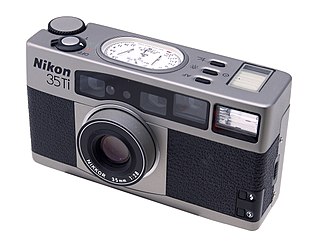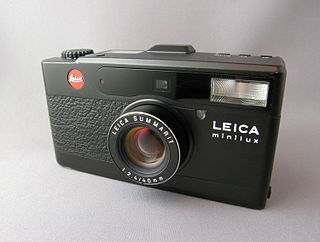
Advanced Photo System (APS) is a film format for consumer still photography first marketed in 1996 and discontinued in 2011. It was sold by various manufacturers under several brand names, including Eastman Kodak (Advantix), FujiFilm (Nexia), Agfa (Futura) and Konica (Centuria). Development was led by Kodak starting in the mid-1980s.
The Instamatic is a series of inexpensive, easy-to-load 126 and 110 cameras made by Kodak beginning in 1963. The Instamatic was immensely successful, introducing a generation to low-cost photography and spawning numerous imitators.

Pentax Corporation was a Japanese camera and optical equipment manufacturer, and currently, it exists as the Pentax Life Care Business Division of Hoya's medical endoscope business, as well as the digital camera brand of Ricoh Imaging, a subsidiary of Ricoh.

The Ricoh Company, Ltd. is a Japanese multinational imaging and electronics company. It was founded by the now-defunct commercial division of the Institute of Physical and Chemical Research (Riken) known as the Riken Concern, on 6 February 1936 as Riken Sensitized Paper. Ricoh's headquarters are located in Ōta, Tokyo.

A point-and-shoot camera, also known as a compact camera and sometimes abbreviated to P&S, is a still camera designed primarily for simple operation. Most use focus free lenses or autofocus for focusing, automatic systems for setting the exposure options, and have flash units built in. They are popular for vernacular photography by people who do not consider themselves photographers but want easy-to-use cameras for snapshots of vacations, parties, reunions and other events.

Rollei was a German manufacturer of optical instruments founded in 1920 by Paul Franke and Reinhold Heidecke in Braunschweig, Lower Saxony, and maker of the Rolleiflex and Rolleicord series of cameras. Later products included specialty and nostalgic type films for the photo hobbyist market.

TC-1 is a luxury point and shoot camera that was produced by Minolta. It is a compact 35 mm clad in titanium, equipped with a G-Rokkor 28mm f/3.5 lens. The TC-1 was equipped with a high quality lens and body, similar to other luxury compacts produced during the Japanese bubble economy era, including the Contax T line, Konica Hexar, Leica minilux, Nikon 28/35Ti, Ricoh GR series, and Rollei QZ 35W/35T. Expensive when initially released in 1996 with a suggested retail price of ¥148,000, it was produced in small numbers and since then has become collectible.
The Olympus AZ-4 Zoom is a 35mm fixed-lens SLR camera introduced in 1989.

The Rolleiflex SL35 is a range of SLR cameras manufactured and sold by the German camera maker Rollei from 1970 to 1982. This range of cameras uses 35mm film. The camera bodies were initially made in Germany. After Zeiss Ikon discontinued camera production, Rollei acquired the Voigtländer brand and camera designs in 1972, and began producing a second generation of SLR cameras in Singapore starting from 1976. Some of those second-generation cameras were rebranded and marketed as Voigtländer VSL.

The Nikon FM10 is a manual focus 35 mm film camera formerly sold by Nikon Corporation. It is of SLR design and was first available in 1995. It is normally sold in a kit that includes a Zoom Nikkor 35–70 mm f/3.5-4.8 zoom lens, although a Zoom Nikkor 70–210 mm f/4.5-5.6 zoom lens is also available. An electronic companion model known as the FE10 was also sold at one stage.

The Pentax K10D and similar Samsung GX-10 are 10.2-megapixel digital single-lens reflex cameras launched in late 2006. They were developed in a collaboration between Pentax of Japan and Samsung of South Korea.

The Leica M mount is a camera lens mount introduced in 1954 with the Leica M3, and a range of lenses. It has been used on all the Leica M-series cameras and certain accessories up to the current film Leica M-A and digital Leica M11 cameras.

The Ricoh GR was a series of point-and-shoot, or compact, 35 mm film cameras made by Ricoh and introduced between 1996 and 2001. Specific camera models include the GR1, GR10, GR1s, GR1v, and GR21. The GR name was later used for Ricoh's GR series of digital cameras, which began production in 2005.

The Ricoh GR is a series of point-and-shoot, or compact, digital cameras made by Ricoh. The GR name was previously used for Ricoh's GR series of film cameras. Like the GR film cameras and Fujifilm X70, the GR digital cameras use metal bodies fitted with bright, permanently-attached prime lenses. In general, the GR digital cameras follow the precedent set by the original GR1 (1996) with lenses that provide a field of view equivalent to a 28 mm wide angle lens on a 35mm film camera.
The Contax T camera line consists of a number of compact cameras sold by Kyocera under the Contax brand. They were introduced between 1984 and 2002. The T, T2, and T3 use 35mm film and have a fixed 35 mm wide-angle lens. The T-VS, T-VS II, and T-VS III also use 35 mm film but have a 28–56 mm lens. The Tix uses APS film and has a fixed 28 mm wide-angle lens. The TVS Digital is a 5 MP digital camera with a 35–105 mm (equivalent) lens.

The Nikon 35Ti (1993) and Nikon 28Ti (1994) are luxury titanium-clad point and shoot cameras that were produced by Nikon, equipped with a high-quality lens and body, competing with similar luxury compact cameras produced during the Japanese bubble-economy era, including the Contax T line, Konica Hexar, Leica minilux, Minolta TC-1, Ricoh GR series, and Rollei QZ 35W/35T. Both the 35Ti and 28Ti are 35 mm cameras with nearly identical operation; as the name implies, the 35Ti is equipped with a 35 mm focal length lens, while the 28Ti is equipped with a 28 mm lens. Externally, they may be distinguished by their color: the 35Ti is finished in chrome/silver, and the 28Ti is finished in black.

The Leica minilux is the first in a series of four luxury titanium-clad point and shoot cameras that were produced by Leica Camera starting from 1995; it is equipped with a high-quality lens and body to compete with similar premium compact cameras produced during the Japanese bubble-economy era, including the Contax T line, Konica Hexar, Nikon 28Ti/35Ti, Minolta TC-1, Ricoh GR series, and Rollei QZ 35W/35T. All of the cameras in the minilux series, including the original minilux, Leica minilux zoom (1998), Leica CM (2004), and Leica CM ZOOM used 35 mm film; the minilux and CM were equipped with the same Leica Summarit lens, while the minilux zoom and CM Zoom were equipped with a Vario-Elmar lens.
The Rollei QZ 35W and 35T are luxury titanium-clad point and shoot cameras that were produced by Rollei starting from 1997; they are equipped with a high-quality Rollei VarioApogon lens and body to compete with similar premium compact cameras produced during the Japanese bubble-economy era, including the Contax T line, Konica Hexar, Leica minilux, Nikon 28Ti/35Ti, Minolta TC-1, and Ricoh GR series. Both of the cameras used 35 mm film; the 35W was equipped with a wide-angle zoom lens (28~60 mm), while the 35T was equipped with a standard to short telephoto zoom lens (38~90 mm).

The Vito and Vitomatic, Vitoret, and Vito Automatic were several related lines of 35 mm compact viewfinder and rangefinder cameras made by Voigtländer from the 1940s through the early 1970s, equipped with leaf shutters, similar in concept to and marketed against the competing Kodak Retina cameras manufactured by Kodak. All of these cameras were fixed-lens models; the models in the Vito line identified with Roman numerals were equipped with folding mechanisms and collapsible lenses for portability, while the others were rigid, non-folding cameras.
















